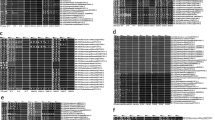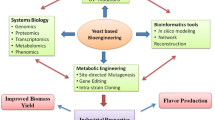Abstract
The conventional baker’s yeast, Saccharomyces cerevisiae, is the indispensable baking yeast of all times. Its monopoly coupled to its major drawbacks, such as streamlined carbon substrate utilisation base and a poor ability to withstand a number of baking associated stresses, prompt the need to search for alternative yeasts to leaven bread in the era of increasingly complex consumer lifestyles. Our previous work identified the inefficient baking attributes of Wickerhamomyces subpelliculosus and Kazachstania gamospora as well as preliminarily observations of improving the fermentative capacity of these potential alternative baker’s yeasts using evolutionary engineering. Here we report on the characterisation and improvement in baking traits in five out of six independently evolved lines incubated for longer time and passaged for at least 60 passages relative to their parental strains as well as the conventional baker’s yeast. In addition, the evolved clones produced bread with a higher loaf volume when compared to bread baked with either the ancestral strain or the control conventional baker’s yeast. Remarkably, our approach improved the yeasts’ ability to withstand baking associated stresses, a key baking trait exhibited poorly in both the conventional baker’s yeast and their ancestral strains. W. subpelliculosus evolved the best characteristics attractive for alternative baker’s yeasts as compared to the evolved K. gamospora strains. These results demonstrate the robustness of evolutionary engineering in development of alternative baker’s yeasts.









Similar content being viewed by others
References
Adams J, Puskas-Rozsa S, Simlar J, Wilke CM (1992) Adaptation and major chromosomal changes in populations of Saccharomyces cerevisiae. Curr Genet 22(1):13–19. https://doi.org/10.1007/BF00351736
Ahi M, Hatamipour M, Goodarzi A (2010) Optimization of leavening activity of baker’s yeast during the spray-drying process. Dry Technol 28(4):490–494. https://doi.org/10.1080/07373931003613726
Aldhous P (1990) Genetic engineering. Modified yeast fine for food. Nature. https://doi.org/10.1038/344186b0
Altobelli E, Del Negro V, Angeletti PM, Latella G (2017) Low-FODMAP diet improves irritable bowel syndrome symptoms: A meta-analysis. Nutrients. https://doi.org/10.3390/nu9090940
Aslankoohi E, Herrera-Malaver B, Rezaei MN, Steensels J, Courtin CM, Verstrepen K (2016) Non-conventional yeast strains increase the aroma complexity of bread. PLoS ONE 11(10):e0165126. https://doi.org/10.1371/journal.pone.0165126
Attfield P (1997) Stress tolerance: the key to effective strains of industrial baker’s yeast. Nature Biotechnol 15:1351–1357. https://doi.org/10.1038/nbt1297-1351
Banat I, Nigam P, Singh D, Marchant R, McHale AP (1998) Ethanol production at elevated temperatures and alcohol concentrations: Part I—Yeasts in general. World J Microbiol Biotechnol 14:809–821
Bennett AF, Hughes BC (2009) Microbial experimental evolution. Am J Physiol Regul Integr Comp Physiol 297(1):R17–R25. https://doi.org/10.1152/ajpregu.90562.2008
Bonet A, Rosell C, Caballero PA, Gómez M, Pérez-Munuera I, Lluch MA (2006) Glucose oxidase effect on dough rheology and bread quality: A study from macroscopic to molecular level. Food Chem 99:408–415. https://doi.org/10.1016/j.foodchem.2005.07.043
Botstein D, Chervitz SA, Cherry MJ (1997) Yeast as a model organism. Science 277(5330):1259–1260. https://doi.org/10.1126/science.277.5330.1259
Cakar ZP, Alkim C, Turanli B, Tokman N, Akman S, Sarikaya M, Tamerler C, Benbadis L, Francois JM (2009) Isolation of cobalt hyper-resistant mutants of Saccharomyces cerevisiae by in vivo evolutionary engineering approach. J Biotechnol 143(2):130–138. https://doi.org/10.1016/j.jbiotec.2009.06.024
Çakar ZP, Turanlı-Yıldız B, Alkım C, Yılmaz Ü (2012) Evolutionary engineering of Saccharomyces cerevisiae for improved industrially important properties. FEMS Yeast Res 12(2):171–182. https://doi.org/10.1111/j.1567-1364.2011.00775.x
Caspeta L, Nielsen J (2015) Thermotolerant yeast strains adapted by laboratory evolution show trade-off at ancestral temperatures and preadaptation to other stresses. mBio 6(4):e00431. https://doi.org/10.1128/mBio.00431-15
Cooper TF, Lenski RE (2010) Experimental evolution with E coli in diverse resource environments. I. Fluctuating environments promote divergence of replicate populations. BMC Evol Biol 10(1):1–10. https://doi.org/10.1186/1471-2148-10-11
Da Silva NA, Srikrishnan S (2012) Introduction and expression of genes for metabolic engineering applications in Saccharomyces cerevisiae. FEMS Yeast Res 12(2):197–214. https://doi.org/10.1111/j.1567-1364.2011.00769.x
Deckers M, Deforce D, Fraiture M-A, Roosens NH (2020) Genetically modified micro-organisms for industrial food enzyme production: an overview. Foods 9(3):326. https://doi.org/10.3390/foods9030326
Dragosits M, Mattanovich D (2013) Adaptive laboratory evolution—principles and applications for biotechnology. Microb Cell Fact 12:64. https://doi.org/10.1186/1475-2859-12-64
Fares MA (2015) Experimental Evolution and Next Generation Sequencing Illuminate the Evolutionary Trajectories of Microbes. In: Sablok G, Kumar S, Ueno S, Kuo J, Varotto C (eds) Advances in the Understanding of Biological Sciences Using Next Generation Sequencing (NGS) Approaches. Springer International Publishing, Cham, pp 101–113
Fay JC, Benavides JAJPG (2005) Evidence for domesticated and wild populations of Saccharomyces cerevisiae. PLoS Genet 1(1):66–71. https://doi.org/10.1371/journal.pgen.0010005
Flores CL, Rodriguez C, Petit T, Gancedo C (2000) Carbohydrate and energy-yielding metabolism in non-conventional yeasts. FEMS Microbiol Rev 24(4):507–529. https://doi.org/10.1016/S0168-6445(00)00037-1
Gamero A, Quintilla R, Groenewald M, Alkema W, BoekhoutHazelwood TL (2016) High-throughput screening of a large collection of non-conventional yeasts reveals their potential for aroma formation in food fermentation. Food Microbiol 60:147–159. https://doi.org/10.1016/j.fm.2016.07.006
Gamero Lluna A, de Jong C (2013) Novel yeasts novel flavours. New Food Mag 16:26–28
Giannone V, Longo C, Damigella A, Raspagliesi D, Spina A, Palumbo M (2010) Technological properties of bakers’ yeasts in durum wheat semolina dough. J Ind Microbiol Biotechnol 37(4):371–379
Gibson PR, Shepherd SJ (2010) Evidence-based dietary management of functional gastrointestinal symptoms: The FODMAP approach. J Gastroenterol Hepatol 25(2):252–258. https://doi.org/10.1111/j.1440-1746.2009.06149.x
Gibson B, Geertman J, Hittinger C, Krogerus K, Libkind D, Louis EJ, Magalhães F, Sampaio J (2017) New yeasts—new brews: modern approaches to brewing yeast design and development. FEMS Yeast Res. https://doi.org/10.1093/femsyr/fox038
Goffeau A, Barrell BG, Bussey H, Davis RW, Dujon B, Feldmann H, Galibert F, Hoheisel JD, Jacq C, Johnston M, Louis EJ, Mewes HW, Murakami Y, Philippsen P, Tettelin H, Oliver SG (1996) Life with 6000 genes. Science. https://doi.org/10.1126/science.274.5287.546
Hagman A, Säll T, Compagno C, Piskur J (2013) Yeast “make-accumulate-consume” life strategy evolved as a multi-step process that predates the whole genome duplication. PLoS ONE 8(7):e68734. https://doi.org/10.1371/journal.pone.0068734
Kariluoto S, Vahteristo L, Salovaara H, Katina K, Liukkonen KH, Piironen VJCC (2004) Effect of baking method and fermentation on folate content of rye and wheat breads. Cereal Chem 81(1):134–139
Kim SR, Park Y-C, Jin Y-S, Seo JH (2013) Strain engineering of Saccharomyces cerevisiae for enhanced xylose metabolism. Biotechnol Adv 31(6):851–61. https://doi.org/10.1016/j.biotechadv.2013.03.004
Koszul R, Dujon B, Fischer G (2006) Stability of large segmental duplications in the yeast genome. Genetics 172(4):2211–2222. https://doi.org/10.1534/genetics.105.048058
Lindquist S (1986) The heat-shock response. Annu Rev Biochem 55:1151–1191. https://doi.org/10.1146/annurev.bi.55.070186.005443
Liti G, Carter DM, Moses AM, Warringer J, Parts L, James SA, Davey RP, Roberts IN, Burt A, Koufopanou V (2009) Population genomics of domestic and wild yeasts. Nature 458(7236):337–341. https://doi.org/10.1038/nature07743
Mans R, Daran J-MG, Pronk JT (2018) Under pressure: evolutionary engineering of yeast strains for improved performance in fuels and chemicals production. Curr Opin Biotechnol 50:47–56. https://doi.org/10.1016/j.copbio.2017.10.011
Nagodawithana TW, Steinkraus KH (1976) Influence of the rate of ethanol production and accumulation on the viability of Saccharomyces cerevisiae in" rapid fermentation". Appl Environ Microbiol 31(2):158–162. https://doi.org/10.1128/aem.31.2.158-162.1976
Nevoigt E (2008) Progress in metabolic engineering of Saccharomyces cerevisiae. Microbiol Mol Biol Rev 72(3):379–412. https://doi.org/10.1128/MMBR.00025-07
Ostergaard S, Olsson L, Nielsen J (2000) Metabolic engineering of Saccharomyces cerevisiae. Microbiol Mol Biol Rev 64(1):34–50. https://doi.org/10.1128/MMBR.64.1.34-50.2000
Panadero J, Hernández-López MJ, Prieto JA, Randez-Gil FJA (2007) Overexpression of the calcineurin target CRZ1 provides freeze tolerance and enhances the fermentative capacity of baker’s yeast. Appl Environ Microbiol 73(15):4824–4831. https://doi.org/10.1128/AEM.02651-06
Paquin C, Adams J (1983) Frequency of fixation of adaptive mutations is higher in evolving diploid than haploid yeast populations. Nature 302(5908):495–500. https://doi.org/10.1038/302495a0
Piper PW (1995) The heat shock and ethanol stress responses of yeast exhibit extensive similarity and functional overlap. FEMS Microbiol Lett 134(2–3):121–127. https://doi.org/10.1111/j.1574-6968.1995.tb07925.x
Radecka D, Mukherjee V, Mateo RQ, Stojiljkovic M, Foulquié-Moreno MR, Thevelein JM (2015) Looking beyond Saccharomyces: the potential of non-conventional yeast species for desirable traits in bioethanol fermentation. FEMS Yeast Res. https://doi.org/10.1093/femsyr/fov053
Randez-Gil F, Sanz P, Prieto JA (1999) Engineering baker’s yeast: room for improvement. Trends Biotechnol 17(6):237–244. https://doi.org/10.1016/s0167-7799(99)01318-9
Randez-Gil F, Aguilera J, Codón A, Rincón AM, Estruch F, Prieto JA (2003) Baker’s yeast: challenges and future prospects. In: de Winde Johannes H (ed) Functional genetics of industrial yeasts. Springer, Berlin, pp 57–97
Randez-Gil F, Córcoles-Sáez I, Prieto JA (2013) Genetic and phenotypic characteristics of baker’s yeast: relevance to baking. Annu Rev Food Sci Technol 4:191–214
Ravasio D, Carlin S, Boekhout T, Groenewald M, Vrhovsek U, Walther A, Wendland J (2018) Adding flavor to beverages with non-conventional yeasts. Fermentation 4(1):15. https://doi.org/10.3390/fermentation4010015
Rouillé J, Chiron H, Colonna P, Della Valle G, Lourdin DJ (2010) Dough/crumb transition during French bread baking. J Cereal Sci 52(2):161–169. https://doi.org/10.1016/j.jcs.2010.04.008
Sanchez-Garcia M, Álvaro F, Peremarti A, Martín-Sánchez JA, Royo C (2015) Changes in bread-making quality attributes of bread wheat varieties cultivated in Spain during the 20th century. Eur J Agron 63:79–88. https://doi.org/10.1016/j.eja.2014.11.006
Sies HJ (2014) Role of metabolic H2O2 generation redox signaling and oxidative stress. J Biol Chem 289(13):8735–8741. https://doi.org/10.1074/jbc.R113.544635
Steensels J, Meersman E, Snoek T, Saels V, Verstrepen KJ (2014) Large-scale selection and breeding to generate industrial yeasts with superior aroma production. Appl Environ Microbiol 80(22):6965–6975. https://doi.org/10.1128/aem.02235-14
Steensels J, Snoek T, Meersman E, Nicolino MP, Voordeckers K, Verstrepen KJ (2014) Improving industrial yeast strains: exploiting natural and artificial diversity. FEMS Microbiol Rev 38(5):947–995. https://doi.org/10.1111/1574-6976.12073
Struyf N, Van der Maelen E, Hemdane S, Verspreet J, Verstrepen KJ, Courtin CM (2017) Bread dough and baker’s yeast: an uplifting synergy. Compr Rev Food Sci Food Saf 16(5):850–867. https://doi.org/10.1111/1541-4337.12282
Swamy KBS, Zhou N (2019) Experimental evolution: its principles and applications in developing stress-tolerant yeasts. Appl Microbiol Biotechnol 103(5):2067–2077. https://doi.org/10.1007/s00253-019-09616-2
Takagi H (2017) Construction of baker’s yeast strains with enhanced tolerance to baking-associated stresses. In: Sibirny A (ed) Biotechnology of yeasts and filamentous fungi. Springer, Cham, pp 63–85
Turanlı-Yıldız B, Benbadis L, Alkım C, Sezgin T, Akşit A, Gökçe A, Öztürk Y, Baykal AT, Çakar ZP, François JM (2017) In vivo evolutionary engineering for ethanol-tolerance of Saccharomyces cerevisiae haploid cells triggers diploidization. J Biosci Bioeng 124(3):309–318. https://doi.org/10.1016/j.jbiosc.2017.04.012
White TJ, Bruns T, Lee S, Taylor J (1990) Amplification and direct sequencing of fungal ribosomal rna genes for phylogenetics. In: Innis MA, Gelfand DH, Sninsky JJ, White TJ (eds) Pcr protocols, a guide to methods and applications. Academic Press, San Diego, pp 315–322
Zeyl C (2006) Experimental evolution with yeast. FEMS Yeast Res 6(5):685–691. https://doi.org/10.1111/J.1567-1364.2006.00061.X
Zhou N, Bottagisi S, Katz M, Schacherer J, Friedrich A, Gojkovic Z, Swamy KBS, Knecht W, Compagno C, Piškur J (2017) Yeast-bacteria competition induced new metabolic traits through large-scale genomic rearrangements in Lachancea kluyveri. FEMS Yeast Res. https://doi.org/10.1093/femsyr/fox060
Zhou N, Schifferdecker AJ, Gamero A, Compagno C, Boekhout T, Piškur J, Knecht W (2017) Kazachstania gamospora and Wickerhamomyces subpelliculosus: two alternative baker’s yeasts in the modern bakery. Int J Food Microbiol 250:45–58. https://doi.org/10.1016/j.ijfoodmicro.2017.03.013
Zhou N, Ishchuk OP, Knecht W, Compagno C, Piškur J (2019) Improvement of thermotolerance in Lachancea thermotolerans using a bacterial selection pressure. J Ind Microbiol Biotechnol 46(2):133–145. https://doi.org/10.1007/s10295-018-2107-4
Zhou N, Semumu T, Gamero A (2021) Non-Conventional yeasts as alternatives in modern baking for improved performance and aroma enhancement. Fermentation 7(3):102. https://doi.org/10.3390/fermentation7030102
Funding
This work was funded by the Department of Research and Innovation, Undergraduate Funding, Botswana University of Science and Technology (BIUST).
Author information
Authors and Affiliations
Contributions
TS performed the experiments. NZ conceived the experiments and partly designed the experiments. TS, TB, AG and NZ wrote the paper.
Corresponding authors
Ethics declarations
Conflict of interest
Authors declare that there are no conflicts of interest.
Additional information
Publisher's Note
Springer Nature remains neutral with regard to jurisdictional claims in published maps and institutional affiliations.
Supplementary Information
Below is the link to the electronic supplementary material.
Rights and permissions
About this article
Cite this article
Semumu, T., Gamero, A., Boekhout, T. et al. Evolutionary engineering to improve Wickerhamomyces subpelliculosus and Kazachstania gamospora for baking. World J Microbiol Biotechnol 38, 48 (2022). https://doi.org/10.1007/s11274-021-03226-9
Received:
Accepted:
Published:
DOI: https://doi.org/10.1007/s11274-021-03226-9




